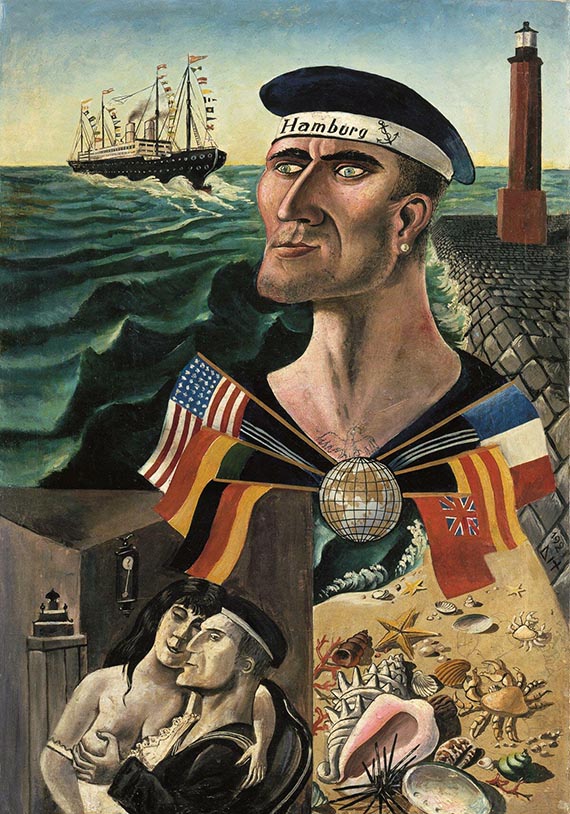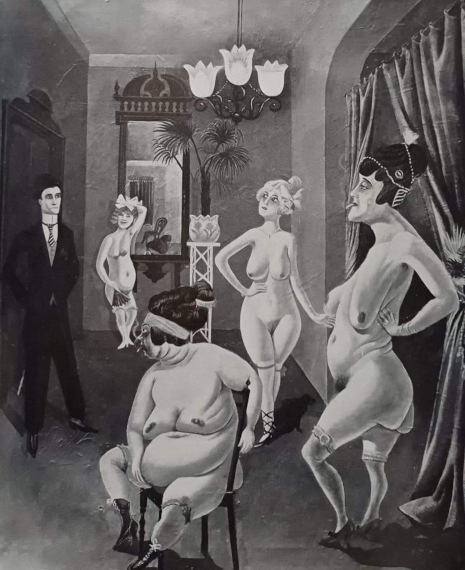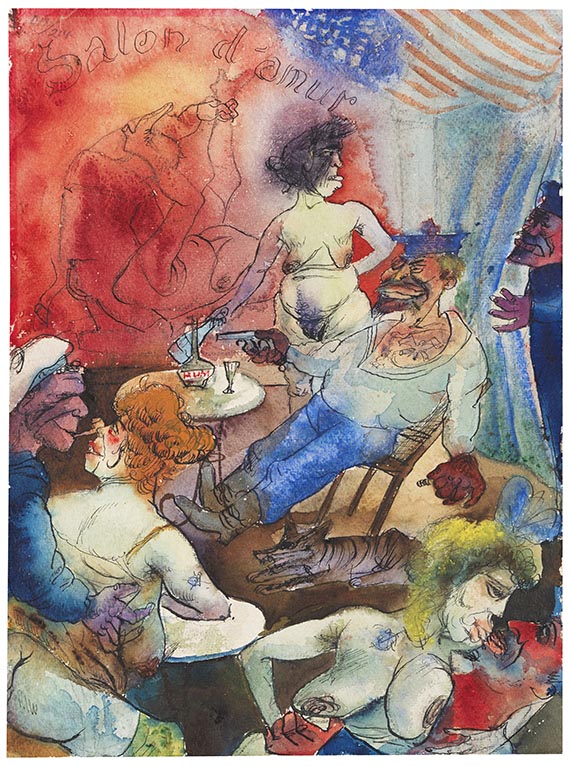Sale: 600 / Evening Sale, Dec. 05. 2025 in Munich  Lot 125001088
Lot 125001088
 Lot 125001088
Lot 125001088
125001088
Otto Dix
Salon d'amur (Matrosenkneipe), Um 1922.
Watercolor and ink pen
Estimate:
€ 150,000 - 250,000
$ 175,500 - 292,500
Information on buyer's premium, taxation and resale right compensation will be available four weeks before the auction.
Otto Dix
1891 - 1969
Salon d'amur (Matrosenkneipe). Um 1922.
Watercolor and ink pen.
Signed and inscribed "214" in the upper left, titled "Salon d'amur" as part of the picture. On laid paper. 33.7 x 24.9 cm (13.2 x 9.8 in), the full sheet.
• Beyond all taboos: loud, pornographic scenes from the demimonde.
• One of only four stunning watercolors with brothel motifs from Hamburg's red-light district.
• Museum quality: multi-figured, picturesque, dense, and unsparing.
• Watercolors from the early 1920s are among the artist's most sought-after works on the international auction market.
• Part of an acclaimed private collection in Berlin for over 45 years.
PROVENANCE: Schmitz Collection, no location specified (acquired in 1948, Hauswedell).
Dr. Ernst Hauswedell & Co., Hamburg (inventory, until 1951).
Private collection, Stuttgart (probably acquired in 1951, Hauswedell).
Private collection, New York (acquired in 1972 from the above, Galerie Wolfgang Ketterer).
Helen Serger, La Boetie, New York.
Private collection, Berlin (acquired from the above in 1978: Hauswedell & Nolte).
EXHIBITION: German Expressionism, Toward a New Humanism, Sarah Campbell Blaffer Gallery/University of Houston, March 3–April 3, 1977, cat. no. 40.
Die Kunst der Dadaisten, La Boetie, New York, September 27–November 27, 1977, cat. no. 7 (illustrated in black and white on p. 9).
LITERATURE: Suse Pfäffle, Otto Dix. Catalogue raisonné of watercolors and gouaches, Stuttgart 1991, CR No. A 1922/117 (illustrated in black and white on p. 166).
- -
Hauswedell & Nolte, Hamburg, 32nd auction, February 7, 1948, lot 2073.
Hauswedell & Nolte, Hamburg, 46th auction, November 3, 1951, lot 2427.
Galerie Wolfgang Ketterer, Munich, 8th auction, November 28, 1972, lot 276 (illustrated in b/w).
The Art Gallery: The International Magazine of Art and Culture, Ivoryton, Conn. Hollycroft Pr., Volume 18, 1974, n.p. (illustrated in color).
Hauswedell & Nolte, Hamburg, 227th auction, June 1-3, 1978, lot 283 (illustrated in color, p. 101).
Otto Dix, 1919, quoted from: Otto Dix – Der böse Blick, Düsseldorf 2017, p. 217.
1891 - 1969
Salon d'amur (Matrosenkneipe). Um 1922.
Watercolor and ink pen.
Signed and inscribed "214" in the upper left, titled "Salon d'amur" as part of the picture. On laid paper. 33.7 x 24.9 cm (13.2 x 9.8 in), the full sheet.
• Beyond all taboos: loud, pornographic scenes from the demimonde.
• One of only four stunning watercolors with brothel motifs from Hamburg's red-light district.
• Museum quality: multi-figured, picturesque, dense, and unsparing.
• Watercolors from the early 1920s are among the artist's most sought-after works on the international auction market.
• Part of an acclaimed private collection in Berlin for over 45 years.
PROVENANCE: Schmitz Collection, no location specified (acquired in 1948, Hauswedell).
Dr. Ernst Hauswedell & Co., Hamburg (inventory, until 1951).
Private collection, Stuttgart (probably acquired in 1951, Hauswedell).
Private collection, New York (acquired in 1972 from the above, Galerie Wolfgang Ketterer).
Helen Serger, La Boetie, New York.
Private collection, Berlin (acquired from the above in 1978: Hauswedell & Nolte).
EXHIBITION: German Expressionism, Toward a New Humanism, Sarah Campbell Blaffer Gallery/University of Houston, March 3–April 3, 1977, cat. no. 40.
Die Kunst der Dadaisten, La Boetie, New York, September 27–November 27, 1977, cat. no. 7 (illustrated in black and white on p. 9).
LITERATURE: Suse Pfäffle, Otto Dix. Catalogue raisonné of watercolors and gouaches, Stuttgart 1991, CR No. A 1922/117 (illustrated in black and white on p. 166).
- -
Hauswedell & Nolte, Hamburg, 32nd auction, February 7, 1948, lot 2073.
Hauswedell & Nolte, Hamburg, 46th auction, November 3, 1951, lot 2427.
Galerie Wolfgang Ketterer, Munich, 8th auction, November 28, 1972, lot 276 (illustrated in b/w).
The Art Gallery: The International Magazine of Art and Culture, Ivoryton, Conn. Hollycroft Pr., Volume 18, 1974, n.p. (illustrated in color).
Hauswedell & Nolte, Hamburg, 227th auction, June 1-3, 1978, lot 283 (illustrated in color, p. 101).
Otto Dix, 1919, quoted from: Otto Dix – Der böse Blick, Düsseldorf 2017, p. 217.
Otto Dix developed a clear, analytical visual language in the early 1920s, marking a new artistic beginning after the war, using his unflinching approach to document the reality of the present time.
With his scandalous watercolor “Salon d'amur (Sailors' Bar),” he succeeded in creating an uncompromising distillation of the provocative, erotically charged atmosphere of the time. Inspired by a memorable stay in Hamburg in 1921, during which he explored the harbor and the red-light district along the Reeperbahn, Dix discovered the motif of the heroic sailor: a figure in a “state of exception” who embodies both sexual virility and social freedom. The sailor is regarded as “a floating, unreal figure who springs from the dreams of land dwellers. He is an escapist fantasy” (quoted from: Timo Heimerdinger, Der Seemann. Ein Berufsstand und seine kulturelle Inszenierung 1844–2003, Cologne 2005, pp. 77 and 198).

Dix presents the concept of freedom and sexual vigor with blunt directness in the “Salon d'amur (Sailors' Bar)” offered here. The crowded sailors' bar is a scene of excessive drinking, desire, and depravity. Sailors, prostitutes, and voyeurs crowd into the stuffy confines of the bar, its red light atmosphere permeated by thick tobacco smoke and perfume. The boundaries between stage and reality become blurred: while an obscene scene in the background goes almost unnoticed, people in the foreground drink, flirt, and smoke. The American flag flies above the scene, symbolizing modern promises, but also alienation and excess. There is a cop at the edge of the picture, an ambivalent figure who promises control but also seems to be part of the action. This dense scene shows Dix's keen sense of social contradictions. The state order appears fragile, its representatives wavering between power and powerlessness. It is therefore not without irony that Dix himself was charged with “indecency” a year later. Among the works that were the subject of the charges was another brothel scene: “Salon II” (1921).

The subject of the sailors' bar occupies a central position in Otto Dix's oeuvre. “Salon d'amur (Sailors' Bar)” can be classified as one of a series of related, high-quality watercolors in which Dix explores the milieu of sailors' brothels (cf. Pfäffle A 1922/75, A 1922/94, A 1922/128). Here, the sailor appears as a symbol of untamed, virile masculinity: excessive, physical, detached from bourgeois morality. As art historian Änne Söll points out, these depictions are a response to the “crisis of masculinity” in the aftermath of World War I. They show the fantasy of an anti-bourgeois existence, free from obligations and entirely devoted to sexual desire.
Dix does not make any moral judgments. His depictions remain sober and serious—an expression of his claim to portray reality unvarnished, even where it eludes public view. As early as 1919, he wrote to his friend Conrad Felixmüller: “I desire to get very close to our present, to be overwhelmingly contemporary, without submitting myself to any artistic dogma.” (Otto Dix, 1919, quoted from: Otto Dix – Der böse Blick, Düsseldorf 2017, p. 217). [KA]
With his scandalous watercolor “Salon d'amur (Sailors' Bar),” he succeeded in creating an uncompromising distillation of the provocative, erotically charged atmosphere of the time. Inspired by a memorable stay in Hamburg in 1921, during which he explored the harbor and the red-light district along the Reeperbahn, Dix discovered the motif of the heroic sailor: a figure in a “state of exception” who embodies both sexual virility and social freedom. The sailor is regarded as “a floating, unreal figure who springs from the dreams of land dwellers. He is an escapist fantasy” (quoted from: Timo Heimerdinger, Der Seemann. Ein Berufsstand und seine kulturelle Inszenierung 1844–2003, Cologne 2005, pp. 77 and 198).

Otto Dix, Abschied von Hamburg, 1921, oil on canvas, Kunstsammlungen Chemnitz-Museum Gunzenhauser, owned by the Gunzenhauser Foundation, Chemnitz. © VG-Bild-Kunst, Bonn 2025
Dix presents the concept of freedom and sexual vigor with blunt directness in the “Salon d'amur (Sailors' Bar)” offered here. The crowded sailors' bar is a scene of excessive drinking, desire, and depravity. Sailors, prostitutes, and voyeurs crowd into the stuffy confines of the bar, its red light atmosphere permeated by thick tobacco smoke and perfume. The boundaries between stage and reality become blurred: while an obscene scene in the background goes almost unnoticed, people in the foreground drink, flirt, and smoke. The American flag flies above the scene, symbolizing modern promises, but also alienation and excess. There is a cop at the edge of the picture, an ambivalent figure who promises control but also seems to be part of the action. This dense scene shows Dix's keen sense of social contradictions. The state order appears fragile, its representatives wavering between power and powerlessness. It is therefore not without irony that Dix himself was charged with “indecency” a year later. Among the works that were the subject of the charges was another brothel scene: “Salon II” (1921).

Otto Dix, Salon II, 1921, oil on canvas, whereabouts unknown.
The subject of the sailors' bar occupies a central position in Otto Dix's oeuvre. “Salon d'amur (Sailors' Bar)” can be classified as one of a series of related, high-quality watercolors in which Dix explores the milieu of sailors' brothels (cf. Pfäffle A 1922/75, A 1922/94, A 1922/128). Here, the sailor appears as a symbol of untamed, virile masculinity: excessive, physical, detached from bourgeois morality. As art historian Änne Söll points out, these depictions are a response to the “crisis of masculinity” in the aftermath of World War I. They show the fantasy of an anti-bourgeois existence, free from obligations and entirely devoted to sexual desire.
Dix does not make any moral judgments. His depictions remain sober and serious—an expression of his claim to portray reality unvarnished, even where it eludes public view. As early as 1919, he wrote to his friend Conrad Felixmüller: “I desire to get very close to our present, to be overwhelmingly contemporary, without submitting myself to any artistic dogma.” (Otto Dix, 1919, quoted from: Otto Dix – Der böse Blick, Düsseldorf 2017, p. 217). [KA]
125001088
Otto Dix
Salon d'amur (Matrosenkneipe), Um 1922.
Watercolor and ink pen
Estimate:
€ 150,000 - 250,000
$ 175,500 - 292,500
Information on buyer's premium, taxation and resale right compensation will be available four weeks before the auction.
Headquarters
Joseph-Wild-Str. 18
81829 Munich
Phone: +49 89 55 244-0
Fax: +49 89 55 244-177
info@kettererkunst.de
Louisa von Saucken / Undine Schleifer
Holstenwall 5
20355 Hamburg
Phone: +49 40 37 49 61-0
Fax: +49 40 37 49 61-66
infohamburg@kettererkunst.de
Dr. Simone Wiechers / Nane Schlage
Fasanenstr. 70
10719 Berlin
Phone: +49 30 88 67 53-63
Fax: +49 30 88 67 56-43
infoberlin@kettererkunst.de
Cordula Lichtenberg
Gertrudenstraße 24-28
50667 Cologne
Phone: +49 221 510 908-15
infokoeln@kettererkunst.de
Hessen
Rhineland-Palatinate
Miriam Heß
Phone: +49 62 21 58 80-038
Fax: +49 62 21 58 80-595
infoheidelberg@kettererkunst.de
We will inform you in time.





